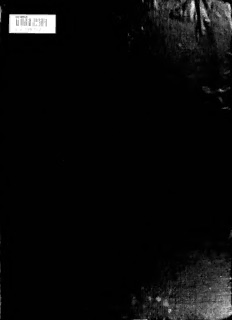
The Ethiopic Didascalia of the Apostolical Constitutions received in the church of Abyssinia PDF
Preview The Ethiopic Didascalia of the Apostolical Constitutions received in the church of Abyssinia
, > fA.^) % "\^ v • * ff Tti ir;^^^- Si*!>ft?%:>*'' ^ tft^' ::&3?^;r '':'a^i^'<^-;'/ THE ETHIOPIC DIDASCALIA; OR, THE ETHIOPIC VERSION THE APOSTOLICAL CONSTITUTIONS RECEIVED IN ^ THE CHURCH OF ABYSSINIA. WITH AN ENGLISH TRANSLATION. KDITED AND TRANSLATED BY THOMAS PELL PLATT, Esq., E.A.S. LATE FELLOW OF TRINITY COLLEGE, CAMBRIDGE. LONDON: PUBLISHED FOR THE ORIENTAL TRANSLATION FUND OF GREAT-BRITAIN AND IRELAND, BY KICHARD BENTLEY, NEW BURLINGTON STREET. M.DCCC.XXXIV. PKINTEI) BY R. WATTS, CROWN COURT, TEMPLE CAR. PREFACE. The ancient language of Abyssinia, commonly called Ethiopic, was but very imperfectly known in Europe before the publication of the Grammar and Lexicon of Ludolf. This very learned, industrious, andaccurate writer wasAulic Counsellor at the Court of the Duke of Saxe Gotha, from about 1652 to 1678, and afterwards his Resident at Frankfort, and President of the Academy of History in that city. His works, which are the great source of information on all subjects relating to the Ancient Language and the Literary and Ecclesiastical History of Abyssinia, are as follows : 1. Jobi Ludolfi Lexicon jEthiopico-Latinum, fol. Francof. ad Moenum, 1699. 2. Grammatica ^thiopica .... fol. ibid 1702. 3. Psalterium DavidisjEthiopice et Latine, curS J. Ludolfi, 4to. ibid. 1701. 4. Jobi Ludolfi Historia jEthiopica fol. ibid 1681. 5. Jobi Ludolfiadsuam Historian] jEthiopicam Commentarius, fol. ibid. 1691. The Grammar and Lexicon were first published in 1661 but these were ; nothing more than rough sketches of the much enlarged and complete works above mentioned, pubhshed in 1699 and 1702. The Ethiopic part of Castell's Polyglott Lexicon seems to have been chiefly composed from the MS. copy of the first edition of Ludolfs Lexicon before it was put to press*. " In one of the works above enumerated, the Commentarius ad Historiam " iEthiopicam," Ludolf has reprinted The Confession of Faith of Claudius King of Ethiopiaf," which had already been pubhshed with the First Edition of his Grammar and Lexicon. In this Confession, Claudius, speaking ofthe Sab- bath, says, that it is observed in Ethiopia, nTnon : }\HH.l : J^O'Cl : chTCyt- : nS^S^tl^A^ "According as our Fathers the Apostles have commanded vis in the Didascalia." On which passage, Ludolfhas the following Note : (Coram, in Hist. Mth. 239 p. :) * SeethePrefacestothetwo editions ofLudolfsLexicon; and Castell,LexiconHeptaglott.col.853. t Claudius reigned firom 1540 to 1559. a 38S996 PREPACK ii " P J^fl^Ay : Arab, (.jdjoil ^1 iidiujiitJJI Didascalia, sive Doctrina, a Graeco AtSaa- KoKia. Revera libellus est ita dictus, Apostolis adscriptus, qui et apud Coptitas reperitur, et tertius est in CoUectione Canonum. Ignotus hucusque fuit ecclesiae Romana; atque GrsecBB. Quisnam sit, plane incertum est, ait Beveregiusin Annot.ad Prooemia et Paraphr. Arab. Cone.Nicaen. p. 211. Europa nondum ilium vidit. Coptitis tantum notus est, a quibus iEthiopes ilium acceperunt. Triginta octo Canones continet, quorum capita infra Lib. iii. c. 4. cum lectoribus communicabimus." In the passage here referred to (Lib. iii. c, 4.), a Table of the Canons of the Didascaha, or rather, of the Titles of its Sections, is given, a copy of which is subjoined to this Preface. This Table was taken by Ludolf from a work of " Wansleb's, which I have never seen, entitled Histoire de I'E'ghse d'Alexandrie." Such is all the information that Ludolf was able to give respecting the Ethiopic Didascaha; and later writers appear to have added httle or nothing to what he has stated. A few years after the publication of Ludolfs works, the Didascaha became a subject of controversy between two celebrated men of that time; the learned Dr. Grabe, and William Whiston. It is well known, that there is a Treatise containing various Rules of Chris- tian Doctrine and Disciphne, called. The Apostohcal Constitutions which was ; originally attributed to Clemens Romanus, and supposed to have been com- piled by him from the Instructions of the Apostles. It has long however been considered as the production of a much later age, and not of higher antiquity than the fourth, or, at any rate, the third century. In the edition of the Councils published by Labbe and Cossart (fol. Paris, 1671), the learned editors prefix—to these Constitutions the following Note on the date oftheir composition : " Sane ut Clementis Romani foetum non esse, ita etiam erudito scriptori, qui 3° saltern seculo floruerit, vindicandum, omnibus hodie persuasum esse video, inquit illust. de Marca, Concordire lib.iii. 2. p. 393. cum in illo commentario antiquaa disciplina; satis expressa vestigia supersint. An vero eaedem sint cum illis quarum Epiphanius meminit adversus hseresim Audianorum uberius alias disputabitur. Interim legePetaviuminnotis ad Epiphan. et tom. II. dogm. theologicorum, Bellarminum de script, eccl. v. Clemens, Gabrielem Albaspineum ep. Aurel. lib. I. observationum, cap. 13. § Certe si quis &c., qui S. Clementi abjudicant." In a later edition ofthe Councils, edited by Mansi, (Florent. 1759) it is argued, chiefly from points of internal evidence, that the true date of the Constitutions is about the beginning of the fourth century ; probably between the Council of Illiberis a.d. 309, and that of Nice, a.d. 325.
Description: